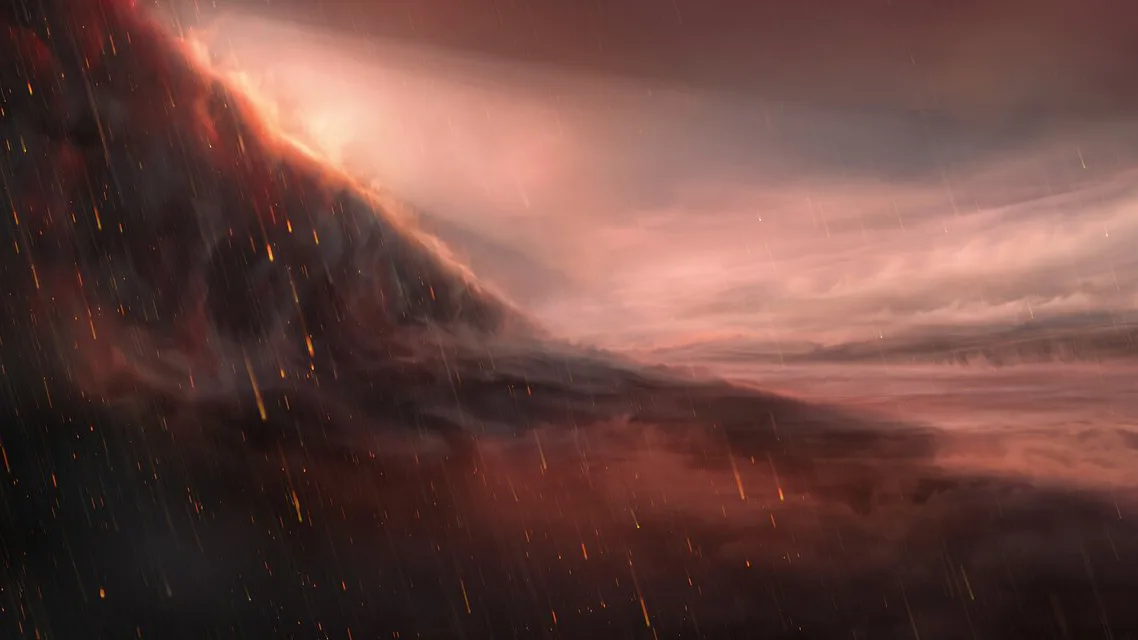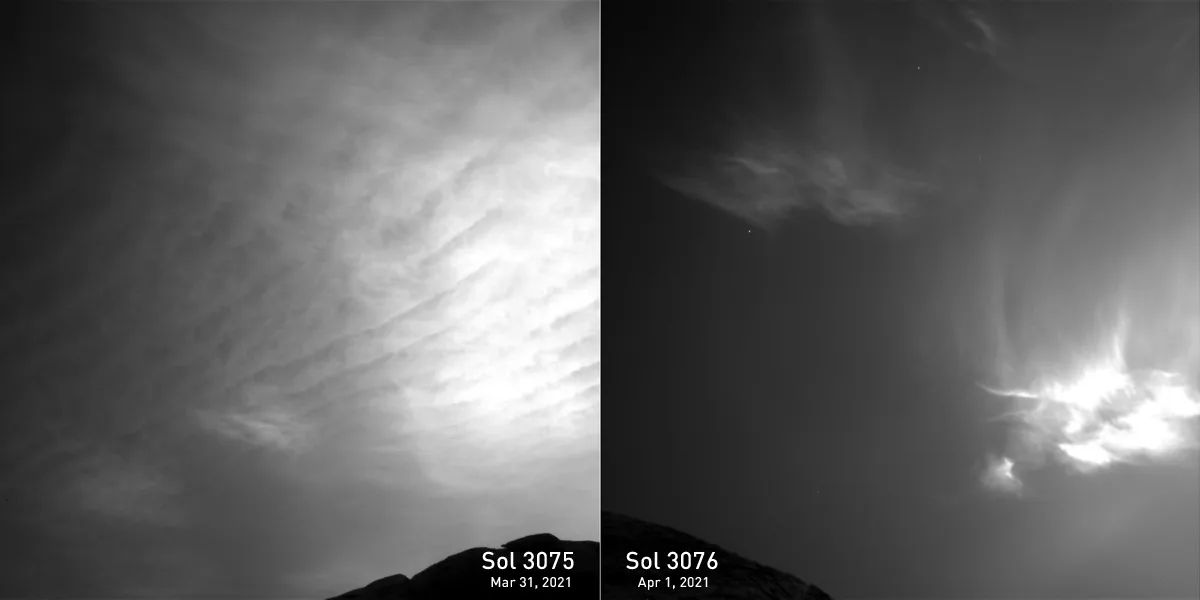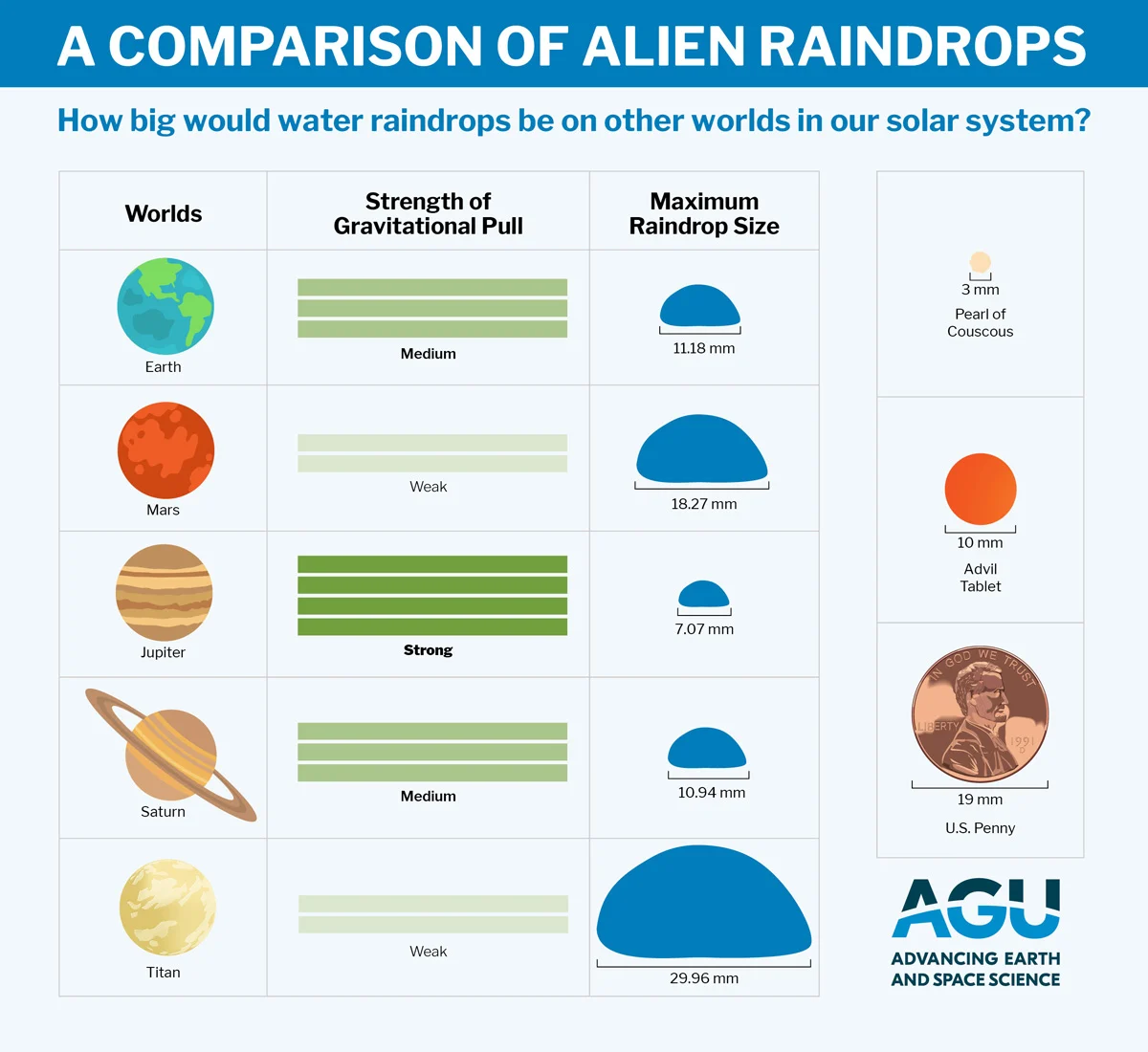
Surprise! Alien raindrops are remarkably like rain we see here on Earth
This research may help us identify habitable planets around other stars.
Alien planets and moons experience rainfall just like Earth. Still, scientists were surprised to learn that raindrops on these worlds are remarkably similar to rain on Earth regardless of their very alien environments.
Throughout our solar system, there are several different worlds where we can find rain. Earth is the most obvious, of course, since rainfall is a common occurrence here. However, we also know that it rains sulfuric acid on Venus, and precipitation consists of helium and diamonds on Jupiter and Saturn. Also, it rains liquid methane on Saturn's moon, Titan. Mars sees its fair share of weather, but we won't see raindrops on the Red Planet these days. Water vapour forms ice crystal clouds high up in the atmosphere, but it's too cold and dry to see raindrops. (Although landers and orbiters have spotted carbon dioxide snowflakes!). However, on ancient Mars, we know it was warmer and wetter, and rain may have been as abundant as it is on Earth today.

Cirrus clouds high above Gale Crater on Mars, imaged by the Right Navigation Camera (Navcam) on NASA's Curiosity rover on Sols 3075 and 3076 (March 31 and April 1, 2021, respectively). Credit: NASA/JPL-Caltech/MSSS/Scott Sutherland
We even know of some exoplanets orbiting around stars other than our Sun where it may rain iron or molten rock.
In a new study, two Harvard University scientists — Kaitlyn Loftus and Robin Wordsworth — examined how raindrops would behave on other planets, compared to how they behave on Earth.
What they found was surprising. It seems that regardless of how different a planet is from Earth or what its rain is made of, the raindrops' maximum size does not differ very much from the raindrops we see on Earth.
"There's a fairly small range of stable sizes that these different composition raindrops can have; they're all fundamentally limited to be around the same maximum size," Loftus, the lead author of the study, said in an American Geophysical Union (AGU) press release.
The limiting factor for how large raindrops can grow on these diverse worlds appears to be the planet or moon's gravitational pull. Specifically, the stronger the gravity is, the smaller the raindrops will be.

This infographic shows the maximum size of raindrops seen on different planets and moons in our solar system. Credit: AGU
In the above infographic from the AGU, the drops may appear to have a fairly wide range of sizes. However, considering the relative mass and gravitational pull of these worlds (Jupiter's gravity is over 2.5 times that of Earth, while Titan's gravity is only 14 per cent of Earth's), the differences in maximum drop size are not as wide as one might expect.
One remarkably consistent similarity is the shape of the raindrops. A 'teardrop' is the most classic shape used to represent a raindrop, but these drops actually start out spherical and then flatten out as they fall through the air. The end result is a raindrop that is flat on the bottom and rounded on the top, like a hamburger bun.
__Watch below: What is rain, and why does it fall? __
THE KEY TO FINDING HABITABLE ALIEN WORLDS?
Along with their study of raindrops that would occur on planets and moons in our own solar system, Loftus and Wordsworth applied their same calculations to planets in other star systems as well.
In doing so, they discovered that they could define an optimal range of raindrop sizes that would reach the surface of a planet. This was done by looking at three specific characteristics of the raindrops — their shape, falling speed, and especially their rate of evaporation.
"The lifecycle of clouds is really important when we think about planet habitability," Loftus said in a Harvard University press release. "But clouds and precipitation are really complicated and too complex to model completely. We're looking for simpler ways to understand how clouds evolve, and a first step is whether cloud droplets evaporate in the atmosphere or make it to the surface as rain."
Tiny raindrops tend to evaporate quickly once they leave the cloud, and the chances of a drop reaching the surface go up as the size of the drop increases. However, if drops get too big, they will split apart as air resistance overcomes the liquid's surface tension, and the resulting smaller drops will evaporate more quickly. Thus, there is a specific range of raindrop sizes that are most likely to survive their journey from the cloud to the ground.

This artist's impression depicts exoplanet K2-18b, a 'super-Earth' planet discovered by the Kepler Space Telescope in 2015. Located around a small red dwarf star around 125 light years away, this planet has about eight times Earth's mass. Based on its proximity to the small star, though, it receives roughly the same amount of heat. Follow-up observations from Hubble and the Spitzer Space Telescope also revealed that the planet likely has a significant amount of water vapour in its atmosphere. Credit: NASA/Hubble
Any planet that does have a significant amount of water rainfall reaching the surface could have a fully realized water cycle, like Earth's. Thus, the chances of such a planet being habitable to us would increase.
"The humble raindrop is a vital component of the precipitation cycle for all planets," Wordsworth, who is an Associate Professor at the Harvard John A. Paulson School of Engineering and Applied Sciences (SEAS), said in the press release. "If we understand how individual raindrops behave, we can better represent rainfall in complex climate models."
"We can use this behaviour to guide us as we model cloud cycles on exoplanets," Loftus added.
